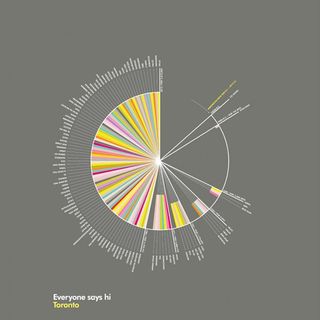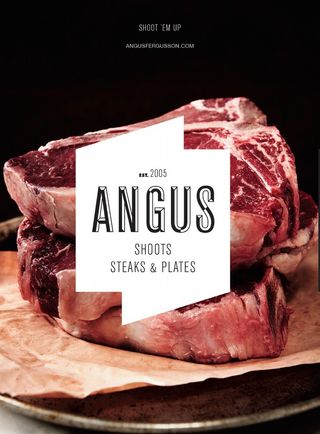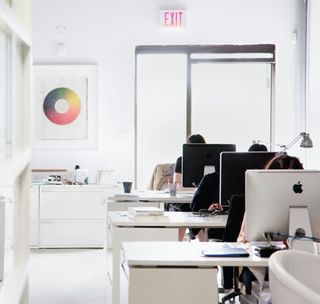Studio founders explain how to get elegance from simplicity
From their Toronto base, Underline Studio co-founders Fidel Peña and Claire Dawson explain what elevates a piece of work from clean and simple to truly elegant.
Bright, late-morning sunlight reflects up off the white lacquered table in Underline Studio's base on the west side of Toronto. "We like it when it blinds the clients," laughs co-founder Fidel Peña. "We always sit on this side," adds Underline's other co-founder, Claire Dawson, indicating their position, where the effect isn't quite so dazzling. "Initially, it blinds them," continues Peña. "We can get them to agree a concept very quickly this way."
But maybe they don't need to resort to such tactics. The studio's work can be just as radiant as the light reflecting off its well-polished table. Founded just under nine years ago, Underline has developed a reputation for elegance - particularly in print design and identity work - that belies its bijou size. Indeed, just six people work in this first-floor studio with its well-worn concrete floors, posters displayed on the walls, and its light, airy atmosphere. Yet the studio's client list includes global household names such as Dyson and Audi.
BMO Financial Group (formerly the Bank of Montreal) is one of Canada's biggest financial institutions and recently became an Underline client when the studio designed the organisation's corporate responsibility report. Underline's roster also lists some of the country's top universities, art galleries and publishers.
One bold new project is for Rethink Breast Cancer, a Canadian charity. "They focus on 20 to 40-year-olds, so this is more of a younger audience," says Dawson. "They've got this big show with the fashion photographer David Jay. He's done a series of portraits of women that have recovered from mastectomies, and they're nudes, so they're quite powerful. They brought us on because they're trying to figure out how to present the work, and they're interested in any number of ways. It's not just a poster campaign."

Normally, a project of this scale, which might just have a bit of a guerilla tendency to it, would go to an agency rather than a small studio. However, Rethink really liked something about Underline's aesthetic, so it'll be doing the design, and getting help from the charity with the media buying side of things.
Artistic connections
Peña and Dawson feel right at home working with photography. For years they've been laying out the Canadian bi-annual photography magazine, Prefix Photo. They've also worked with the photographer Arnaud Maggs, who has been a giant on the Canadian art scene for decades. When the National Gallery of Canada in Ottawa held a retrospective of Maggs' work last year, Underline was drafted in to lay out the show catalogue. The large-format hardback is an impressive piece of design work.
Before taking up photography, Maggs was a designer, so they felt a real connection with him and in return he appreciated Underline's thoughtful approach. "He began his career as a designer and lived in New York for a while designing all sorts of great Jazz albums. Then he switched to become a fashion designer, and then decided to become a photographer and an artist," explains Dawson.
"He was seduced by the spine of the book, because we had wrapped a piece of his art around it so that the numbers on the piece would fit perfectly there. He just loved detail," adds Peña.
"He was just so different to present to," continues Dawson. "You know, most clients look at the cover, there may be some discussion, they may start flipping pages. Arnaud would sit for five minutes and just look at the spine."

The pair got a great rush seeing the book on sale in the gallery's gift shop, and an even bigger one when they walked up the glass-housed ramp towards the exhibition area. The Tungsten lettering they'd used for the book had been blown up to a huge size and was displayed on the gallery wall, pointing visitors to the show.
A strict base
One of the reasons galleries and other institutions that are serious about art choose to work with Underline is down to the studio's classic approach. Real consideration goes into its typography and grids. But more than that, there's a respect for the imagery. You'll rarely see Underline running type over a stunning photo or piece of illustration. It takes you back to the great print layouts of the 1960s - wonderfully clear and arresting in their simplicity.
"With a lot of projects like this, it's about respecting the artist's work. We're not going to layer stuff on top of it. We loved Maggs' work, as an artist, and respected him, so we wanted to pare things back so the work would shine and it would all feel cohesive together," says Dawson. Peña continues: "Everything we do has an underlying logic to it, so if we're setting an article, for example, we'll start from the classic rules of typography. There is a set number of columns, and there is a very strict grid enforced - vertical but also horizontal. The vertical will be the columns but the horizontal will be the baseline grid covering every typeface, every size."
"Then we'll try to do something where we'll do the modern or conceptual approach, based on what the article is about, and deviate from that classic way and try to give some personality to the piece," he says. Then Peña flicks to an article in Prefix Photo to use as an example. The spread he chooses has the headline 'Potential history' broken into syllables which are stacked, centred and sucked into the gutter between the pages.

"This article is talking about the divide between Palestine and Israel, it's about the border and divisions," he explains. "So, visually, for us it was about everything coming into this gutter. Even though the article is clearly classically designed, here we deviated a little. We wanted this to express what the article was about, immediately, almost emotionally."
It's touches like this that move Underline's work from the category of 'clear and simple' into that of 'elegant'. In fact, the studio was founded on the idea of bringing classic and European design sensibilities together, and presenting them on the Canadian scene. Peña, whose family came to Canada from El Salvador when he was a teenager, at first wanted to be an architect. Dawson, meanwhile, studied art but veered towards design. They met working at the respected Toronto studio Concrete. Years later, after Peña had been over to London and worked at Pentagram as part of Fernando Gutierrez's team, they decided to set up Underline.
"It felt like there was an opportunity to do something different in this city," says Peña. "There was not a lot of European sensibility in the work here we thought, and we're both really attracted to European design. So it just felt like it was a good partnership and the right time to do it."
Studio inspirations
Even today, almost nine years later, the pair are inspired by European creatives. Made Thought, Bibliothèque, Fallon, Pentagram, NB and Grafica are just a handful of their favourites. But they look well beyond design as well. "In the beginning we used to look at the work of Bridget Riley all the time. We loved her work. It's op art, so it's very graphic, beautiful colours," says Dawson.
Not surprisingly for a studio so in love with editorial design and with such an appreciation of type and words, they enjoy reading too. "We're big readers both of us - we like the written word - so I think that's why we're respected in print so much. Literature, philosophy, anything driven by thinking is big for us," smiles Peña. When we ask about inspiration, they return to Arnaud Maggs and his partner, the artist Spring Herbert.
"They were very inspiring too, just the way that they lived, that they loved what they did," says Dawson. "Art and life were very seamless. They were very passionate about it. We like meeting people who are very passionate about what they do. We try and keep working in a way that we're very stimulated by it and it still remains very exciting, and something we want to come into work and do every day."

And that is the challenge for Underline Studio going forwards. When it first started off, the pair learned how to run a business, and keep all the admin in check. Then the trick became finding new clients and working with them. Now, Peña and Dawson are trying to figure out the route they want to take to move the studio onward. Is it to grow in size and take on bigger projects? Or is it to stay small and remain hands-on with the design work itself?
"Every year there's a new challenge," says Dawson. "Right now it's about trying to figure out the paths that we want to take and how we want to gear the work that we do, and the life of the studio. We're thinking about it as a larger whole and where we want to take it."
Words: Garrick Webster
Liked this? Read these!
- Create a perfect mood board with these pro tips
- The ultimate guide to logo design
- Illustrator tutorials: amazing ideas to try today!
Seen something elegant lately? Tell us in the comments!

Thank you for reading 5 articles this month* Join now for unlimited access
Enjoy your first month for just £1 / $1 / €1
*Read 5 free articles per month without a subscription

Join now for unlimited access
Try first month for just £1 / $1 / €1
Get the Creative Bloq Newsletter
Daily design news, reviews, how-tos and more, as picked by the editors.
The Creative Bloq team is made up of a group of design fans, and has changed and evolved since Creative Bloq began back in 2012. The current website team consists of eight full-time members of staff: Editor Georgia Coggan, Deputy Editor Rosie Hilder, Ecommerce Editor Beren Neale, Senior News Editor Daniel Piper, Editor, Digital Art and 3D Ian Dean, Tech Reviews Editor Erlingur Einarsson, Ecommerce Writer Beth Nicholls and Staff Writer Natalie Fear, as well as a roster of freelancers from around the world. The ImagineFX magazine team also pitch in, ensuring that content from leading digital art publication ImagineFX is represented on Creative Bloq.
